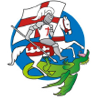Year 1 and 2 RNLI Beach Safety Assembly
Today we had a visit from Andy and Sadie who are beach lifeguards all around the Wirral. We have lots of water surrounding us, because we live on a peninsula which means we have water on 3 sides of our land. These are the River Mersey, River Dee and the Irish Sea.
We learnt that RNLI stands for Royal National Lifeboat Institution. Next year the RNLI is 200 years old! They were founded in 1824, and used to use rowing boats to go out and rescue people, but today they have big boats that are almost unsinkable.
When you see the flag flying outside of a station, that means they’re on duty. They have stations in New Brighton, West Kirby and Hoylake, as well as beach patrols all around our coast. The RNLI have some different flags that they use. The red and yellow flag means it is safe for swimming, the red flag means DANGER and it is not safe to play in the sea. The next flag is black and white which means the area is for surfing and the final flag is orange and says “no inflatables” which means no blow up toys because it’s dangerous and you could get blown out to sea.
We talked about what we should do if we want to go swimming in the sea.
Before we go swimming in the sea, we need to stop and think about where is safe to swim. We should only swim on lifeguarded beaches. Swimming in the sea is very different to swimming in a swimming pool because we don’t know how deep the sea can be, or what dangers are beneath the surface.
It is really important to stay with your family and friends when you’re at the beach, so that you don’t get lost. If you do get lost, you can go to a lifeguard in their red and yellow uniform and they will help you.
We must be prepared when you go to the beach. Remember to take a sun hat, sunglasses, sun cream and water to drink.
If we fall into the water or find ourselves in a rip current, there are some things we can do to help ourselves. We can take deep breaths to stay calm, float in a starfish shape, wave our arm to catch attention and shout help! In a rip current you should try to swim parallel to the shore to get out of it.
We can call 999 or 112 and ask for the Coastguard if we see someone struggling out in the water. We must not go in ourselves to help. The coastguard will know exactly what to do!











